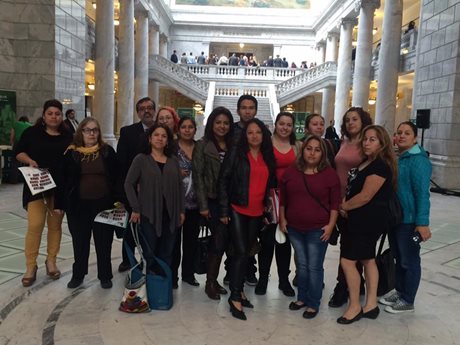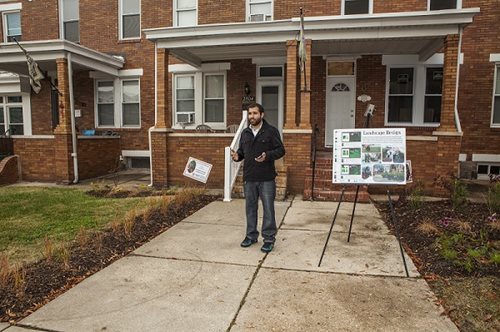Historically, the relationship between “towns” (cities and neighborhoods) and “gowns” (universities) have been rich with potential, but also fraught with challenges. Universities offer so much in the way of employment, external exposure and concentrated expertise, yet both invisible and visible barriers and points of tension exist that can get in the way of truly productive cross-sector collaboration.
Maria Garciaz, executive director of NeighborWorks Salt Lake recalls one day in the year 2000 when a woman from the University of Utah asked to chat with her about another in a series of research projects.
 |
| The recent WLI graduate class in the state capitol. |
So, Garciaz responded with a challenge: “No more. We are not going to be lab rats. We are not going to share more information if we get nothing out of it. Locate an office here and staff it, and then we’ll talk!”
The challenge paid off. A year later, the university rented a house and Garciaz joined the dean of the law school as co-chair of the new University Neighborhood Partners (UNP).
“The old notion of a college or university as an ivory tower, as a bastion of knowledge separate from everyday life, has largely disappeared,” says Paul Kuttner, the UNP’s education pathways partnership manager. “Universities are increasingly recognizing that they have a civic responsibility to their neighborhoods, cities and states. Public universities like the University of Utah, in particular, have to demonstrate that they are having a positive impact on the states that fund them. But also, the work we do at a university – teaching and research – is simply better when it is carried out in the real world, addressing real problems. Movements for community-engaged learning and community-engaged research are growing because they can accomplish two goals at once: improving life in our communities and building knowledge.”
One of the first products of the creation of UNP was a focus on resident empowerment and leadership. Residents the UNP founders that, “We don’t want people to lead us. We have our own leaders; they just need to be trained on how to use the system.” Thus, the Westside Leadership Institute was born, in partnership with NeighborWorks Salt Lake, with graduates becoming future teachers.
This year, 27 students from the first Spanish-language institute are working on four projects (related to immigration, child abuse, adults enrolled in post-secondary education and substance abuse). Each team developed a presentation designed to seek sponsors and partnerships. After graduation, students are encouraged to apply for a matching grant through NeighborWorks Salt Lake and UNP to kick off their projects.
Here are a few more examples of community development-university partnerships:
Harnessing specific expertise
In Baltimore, St. Ambrose Housing Aid Center received a Catalytic Grant from NeighborWorks America to help defend the working-class Northeast Baltimore community of Belair-Edison against the forces that have pummeled it and others: blockbusting and white flight, predatory lending and foreclosures, a loss of blue-collar jobs and crime. |
| A graduate in landscape architecture describes a design his team developed. |
A place like Belair-Edison, neither wealthy nor impoverished, is "vital to the overall health and future of the city," David Sann, a longtime neighborhood advocate.
St. Ambrose staff drove down every street of the community, surveying all of the partially or totally boarded homes. Then the NeighborWorks member targeted 33 that were “visually ‘in your face’ because of their location on a corner or on a gateway street. The staff tracked own the owners, seeking to acquire and restore as many of the properties as it could. St. Ambrose partnered with graduate students from the Morgan State University landscape architecture department to develop three designs from which the homebuyers could choose, tailored to whether or not a house has a front porch and is on a flat versus hilly lot. A guide to maintenance during the different seasons is offered as well.
Tapping into what universities do best
Another Catalytic Grant recipient, the CDC of Tampa, used some of its funds to participate in the collection of both qualitative and quantitative research conducted by a professor of urban planning at the University of South Florida. The nonprofit is working to transform the East Tampa and Sulphur Springs neighborhoods into vibrant communities of choice. While the CDC of Tampa conducted NeighborWorks' Community Impact Measurement survey in the eastern neighborhood, a universitiy team conducted a similar study in Sulphur Springs, The university combined the findings witih secondary research sources such as census data and unemployment trends to create a neighborhood-level report card."The report card is being translated into a scorecard--a dashboard of sorts--that we will share with local associations and civic groups to engage them in conversation around our collective priorities going forward," explains Stephen Ponzillo, director of special projects.
Hea adds that the research project was a natural partnership with the university that built on the nonproofit's ongoing relationship with the university's community outreach office, which has included internships and collaborations on youth environmental activities, such as creation of a rain garden.
Helping universities be ‘employers of choice’
The University of Rochester has partnered with NeighborWorks Rochester and other area service providers to benefit its employees by offering services such as homebuyer education, assistance with closing costs and affordable home-repair loans.Developing programming with credibility
NeighborWorks America has long taken the lead in collaboration with universities. Harvard University’s Kennedy School of Government is our partner in offering the NeighborWorks Achieving Excellence Program, an 18-month experience during which nonprofit leaders tackle the most important organizational challenges that, when met, would position their organizations to thrive and better serve their communities.Likewise, NeighborWorks has partnered with Brown School at Washington University in St. Louis to offer a certificate program combining the disciplines of social work and housing asset management. In this visionary training program, students learn best practices in both spheres, developing both the business skills associated with housing management as well as the life-changing skills of successful social service work. Training leads to a professional certificate in affordable housing and mixed-income community management.
Forging your own partnership
“As someone who convenes partnerships between universities and communities, I look first for a willingness to partner and a collaborative attitude,” says Kuttner. “A good partnership is about listening to and learning from one another, not trying to push one agenda. At the same time, a good partner is honest about its goals and interests right up front, and recognizes when the fit isn’t good. And finally, I look for groups that have strong relationships with community residents. Just because an organization is located in a community, doesn’t mean it is of that community. That’s a huge strength NeighborWorks Salt Lake brings to our partnerships.”How would an organization find the best “doorway in” when approaching a university? Here is Kuttner’s advice: Some universities have departments like ours, whose purpose is to build these partnerships. However, our model is not too common; many more universities have community-engaged learning centers, which at the very least will have relationships with faculty who are interested in partnering with community groups. Failing that, I’d say just start reading up on faculty who work in the same area that you do, then ask for a meeting. Ask about what their interests are – what they teach, what they study – and look for areas of connection. Remember, too, that universities are huge, diverse institutions. A bad experience with one faculty member or department will not necessarily be the same with another. The more people you talk to about your interest, the more likely someone is respond and say ‘yes’!”

